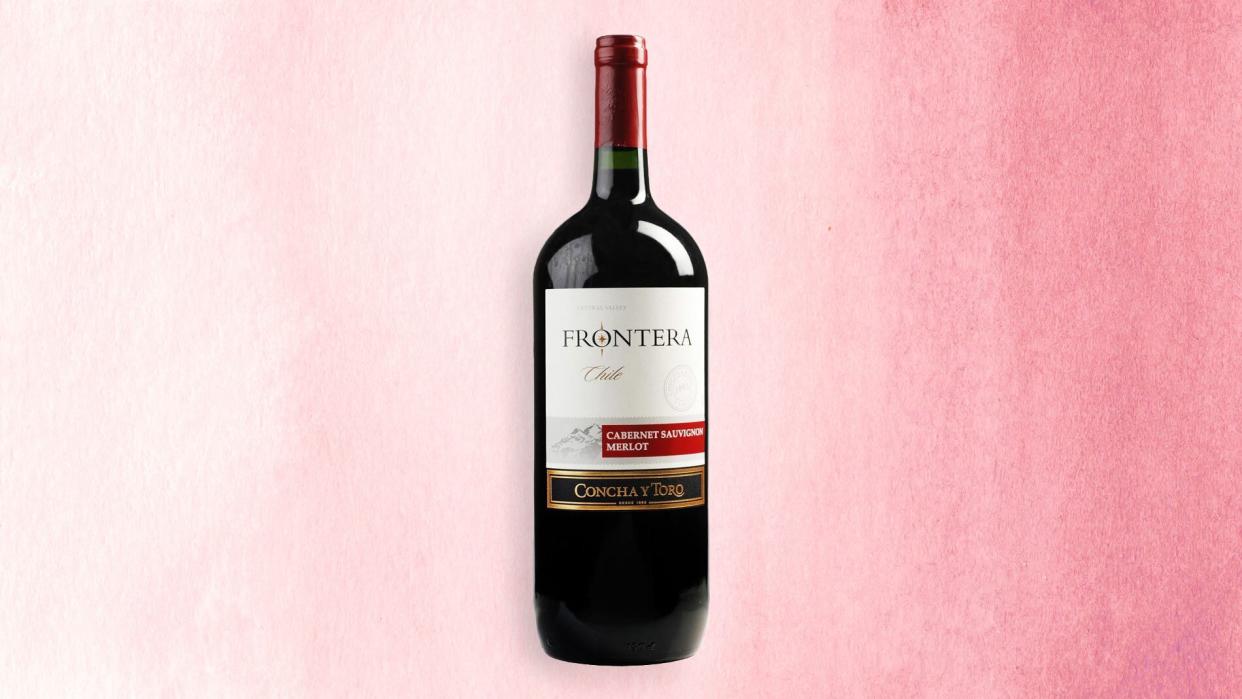How This $3 Bottle of Wine Came to Be So Beloved

Courtesy of Amazon; Getty Images/iStockphoto
On a recent trip to a Supermarket Fiesta in Houston, Rosa Garcia was lugging twelve bottles of Concha y Toro Frontera wine when a woman stopped her and asked her if that stuff was any good.
"Oh no, I just use it for cooking," Garcia said. She was lying. She doesn't want the prices to go up of what has become her and her husband Michael Gilcrease's favorite wine, and she suspects this will happen if too many people start drinking it. At Fiesta, you can buy three bottles of Frontera for $9.99. Prices vary slightly around the country, but it's typically the cheapest bottle at any given wine shop.
Despite its budget reputation, Frontera has accumulated a devoted following from people around the country who think it tastes great—at least as good as anything you'd buy in the $15 range. Since Garcia discovered the wine at the supermarket last year, she and Gilcrease drink exclusively Frontera with their dinners, often pairing it with spicy Mexican dishes. The wine is made in Chile at the Concha y Toro vineyards, and Garcia, who is from Zacatecas, Mexico, can discern uniquely Latin American flavors.
"With food in general, even vegetables and fruits, you can tell that Mexican and Latin American flavors are different, and I think it's true for wine as well," she says. "You can tell that it's tailored for that sort of a palate. Even a tomato, here versus there—my husband is laughing—it tastes different. I cook, so I'm more knowledgeable about those subtle things. I moved here thirty-two years ago, but I travel frequently there. I still feel foreign here."
Michael Bishop, another one of Frontera's numerous but well-hidden devotees, first discovered the wine in 1990, when he was working his first restaurant job in Tampa, Florida and their house wine was Frontera's Cab/Merlot blend.
"While I've been exposed to wines from every level—I once helped cook a wine dinner for Romanée-Conti at Bern's Steak House—I never shied away from keeping a few bottles of that Frontera wine around," Bishop says. "And when asked about an 'inexpensive' drinkable wine, it often is my first recommendation due to its availability in Publix when people are shopping for a quick dinner."
Wine industry experts recognize the significance of Concha Y Toro, which is the largest producer of wines in Latin America. Dustin Wilson, a master sommelier and the founder of Verve Wine, isn't surprised by its mass appeal—even though it's not his go-to.
"Concha y Toro is one of Chile's largest and most important wineries, and I know that Cabernet grows in abundance down in Chile and the quality of fruit can be quite high while the cost remains relatively low when compared to other spots around the world that do well with that grape," he says, though he prefers a different inexpensive bottle. "Personally, when I'm going for bang for the buck, I tend to look at southern France. Lots of places with old vines and cool, interesting grapes that can play well with food. Petit Canet, for example, I think over-delivers for the price ($12)."
For Garcia and Gilcrease, the discovery of Frontera has shifted their wine-drinking habits.
"We used to drink pretty occasionally," Gilcrease says. "But now that we've discovered the good cheap wine, we drink more frequently. We know you can get addicted if you drink so much, but now it's sort of tempered by the fact that it's so cheap."
Of course, Frontera's cheapness can be off-putting—especially if you're bringing a bottle to a special occasion and worried that people will judge you. Garcia and Gilcrease recently embarrassed their son by serving Frontera at a last-minute dinner with his fiancé and her parents.
"We thought, Oh, what do we have … and of course that's all we have," Gilcrease says. "So we took it out and we served it. Brian knew it was cheap—they may not have known, but he knew and was very embarrassed. I think they liked it."
